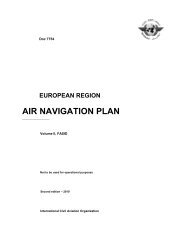7754 Vol 1 Flyleaf - ICAO Public Maps
7754 Vol 1 Flyleaf - ICAO Public Maps
7754 Vol 1 Flyleaf - ICAO Public Maps
Create successful ePaper yourself
Turn your PDF publications into a flip-book with our unique Google optimized e-Paper software.
IV-6 EUR BASIC ANP<br />
sub-regional programmes, e.g. SESAR.<br />
54. The following are key driving factors to the development<br />
of the Roadmap:<br />
a) Move towards GNSS becoming the prime<br />
positioning source for all phases of flight<br />
using Galileo/GPS/GLONASS, GBAS<br />
and SBAS;<br />
b) SBAS (Satellite-Based Augmentation<br />
System) becomes available for suitably<br />
equipped aircraft to enable increased<br />
access to medium and smaller airports in<br />
the time frame until about 2013;<br />
c) GBAS (Ground-Based Augmentation<br />
System) becomes available using GPS L1<br />
for some users in particular operating<br />
environments in the time frame until about<br />
2013;<br />
d) A mandate for the carriage of GNSS is<br />
envisioned for application in certain parts<br />
of the EUR by 2015;<br />
e) Evolution of improved low visibility<br />
operations using GBAS to support CAT II<br />
and III operations with GPS L1 then with<br />
multi constellation GNSS;<br />
f) 4D trajectory management is foreseen<br />
beyond 2020;<br />
g) Advanced RNP with an initial Required<br />
Time of Arrival (RTA) capability is a step<br />
towards 4D trajectory management;<br />
h) Extended use of RNAV1/P-RNAV for<br />
approach as a means of transitioning from<br />
permanent routes through Conditional<br />
Routes to 4D Business/Mission<br />
Trajectories;<br />
i) The continued provision of DME as a<br />
backup to GNSS is consistent with safety<br />
targets;<br />
j) Replacement of Conventional<br />
Non-Precision Approaches by approaches<br />
with vertical guidance up to 2016;<br />
k) The progressive decommissioning of<br />
VORs and NDBs made possible by the<br />
GNSS evolution.<br />
Principles of PBN Implementation<br />
55. The broad principles for PBN Implementation derived<br />
from the operational requirements of the EUR Region and<br />
the concepts and strategies discussed above are:<br />
a) The Navigation Application and<br />
Infrastructure Strategy is required to meet<br />
the requirements detailed in the <strong>ICAO</strong><br />
Global ATM Operational Concept. As<br />
such, the Roadmap lays the foundations for<br />
achieving the goals of User Preferred<br />
Trajectories together with improved<br />
access, safety and reduced environmental<br />
impact targets;<br />
b) GNSS becomes the primary and<br />
potentially a sole means of navigation, to<br />
the degree that this can be demonstrated to<br />
be safe and cost effective; and<br />
c) Given that satellite-based Navigation<br />
increasingly co-exist with satellite-based<br />
Surveillance and Communication services,<br />
the Roadmap takes due account of all<br />
ATM/CNS components.<br />
56. The application of these principles shall:<br />
a) identify and evolve from the needs and<br />
priorities of both users and providers of the<br />
navigation systems and/or services;<br />
b) provide tangible and early benefits for the<br />
users;<br />
c) safeguard capital investments, necessary to<br />
maintain the existing infrastructure and<br />
future rationalisation plans;<br />
d) take due account of sub-regional<br />
institutional arrangements and regulations;<br />
e) accommodate geographical differences in<br />
capabilities, performance requirements<br />
and infrastructure;<br />
f) enable coherent development plans within<br />
the EUR region and ensure an appropriate<br />
interface to the adjacent regions; and<br />
g) Accept the continued operations of aircraft<br />
with lower navigation capabilities for as<br />
long as operationally feasible.<br />
Benefits<br />
57. The following are the benefits expected to be derived by<br />
implementation of PBN:<br />
a) Improved safety, efficiency and reduced<br />
environmental impact through the<br />
implementation of continuous and














